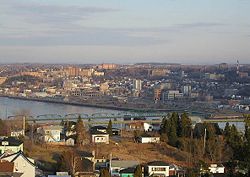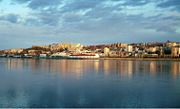Saguenay, Quebec
| Saguenay, Quebec | |
| Ville de Saguenay | |
 |
|
|
|
|
| Coordinates: | |
| Country | Canada |
|---|---|
| Province | Quebec |
| Region | Saguenay–Lac-Saint-Jean |
| Established | February 18, 2002 |
| Government | |
| - City Mayor | Jean Tremblay (since 2002) |
| - Governing body | Saguenay City Council |
| - MPs | Robert Bouchard (BQ), Jean-Pierre Blackburn (C) |
| - MNAs | Stéphane Bédard (PQ), Jacques Côté (PQ), Sylvain Gaudreault (PQ) |
| Area | |
| - City | 1,165.997 km² (450.2 sq mi) |
| - Land | 1,753.69 km² (677.1 sq mi) |
| - Urban | 131.32 km² (50.7 sq mi) |
| Elevation | 166 m (545 ft) |
| Population (2006) | |
| - City | 143,692 |
| - Density | 128.6/km² (333.1/sq mi) |
| - Urban | 106,103 |
| - Urban Density | 808.0/km² (2,092.7/sq mi) |
| - Metro | 151,643 |
| - Metro Density | 86.5/km² (224/sq mi) |
| Time zone | EST (UTC-5) |
| - Summer (DST) | EDT (UTC-4) |
| Postal code span | G7(B,G-K,N,S-T,X-Z), G8A |
| Area code(s) | 418 |
| Website: Ville de Saguenay | |
Saguenay is a city (Canada 2006 Census population 143,692) in the Saguenay–Lac-Saint-Jean region of Quebec, Canada, on the Saguenay River, about 200 kilometres (120 mi) north of Quebec City.
Saguenay is also the name of a territory equivalent to a regional county municipality (TE) coextensive with the city of Saguenay, whose geographical code is 941.
Together with the regional county municipality of Le Fjord-du-Saguenay, it forms the census division (CD) of Le Saguenay-et-son-Fjord (94).
Contents |
Description
The city was formed on February 18, 2002 by amalgamating the cities of Chicoutimi, Jonquière, La Baie and Laterrière, along with the municipalities of Lac-Kénogami and Shipshaw and part of the township of Tremblay.
The city is divided into three boroughs:
- Chicoutimi (territories of Chicoutimi, Laterrière and Tremblay township);
- Jonquière (territories of Jonquière, Arvida, Kénogami, Lac-Kénogami, and Shipshaw);
- La Baie (territory of La Baie).
The mayor of Saguenay is Jean Tremblay, mayor of Chicoutimi before the merger.
The term "the Saguenay" or (less commonly) "Saguenay Valley" is used for the whole Saguenay River region. See Saguenay-Lac-Saint-Jean. The provincial riding of René-Lévesque on the Côte Nord was named Saguenay before 2003 elections.
Camrose, Alberta is the sister city of Saguenay.
Geography

Saguenay is located in a depression in the Canadian shield with a somewhat more temperate climate than the surrounding region, allowing agriculture and human settlement to take place. The relatively small and concentrated Lac St-Jean area where the city is located can be described as an isolated "oasis" in the middle of the vast remote wilderness of Northern Quebec. Few roads connect with the area from the south and east, and only one road connects from the northwest. No roads go north from the area into the wilderness; the last roads north end just a short distance from the city—still within the Lac St-Jean area. There are no human settlements due north of Saguenay all the way to the Canadian Arctic islands, except for a few isolated Cree and Inuit villages. However, the remote, paved Route 167/113 heads northwest to the interior town of Chibougamau, providing access to Western Quebec and subsequently, Hudson Bay. No services are available for the 230 km (143 mi) to Chibougamau from the Lac St-Jean area.
Two notable natural disasters have occurred within the current municipal boundaries of Saguenay: the Saint-Jean-Vianney landslide of May 4, 1971, and the Saguenay Flood of 1996. A magnitude 5.9 earthquake on November 25, 1988 also had its epicentre 35 km south of Chicoutimi.
Demographics
(Institut de la Statistique du Québec, 2006)
| Population density (2006) | 127.0 inhabitants per square kilometre (328.9/sq mi) |
| Total population (2006) | 144,250 inhab. |
| Net interregional migration (2005-2006) | -742 inhab. |
| Population projections (population changes 2026/2001) | - 12.7% |
| Number of workers, 25-64 years (2004) | 56,516 |
| Rate of workers, 25-64 years (2004) | 68.5% |
| Average employment income of workers, 25-64 years (2004) | $39,723 |
| Employment-assistance rate (2006) | 9.2 % |
| Low-income rate among families (2004) | 8.1 % |
| Per capita personal income (2005) | $28,415 |
| Total value of building permits (2006) | $187,305k |
| Average assessed value of single-family dwellings (2006) | $98,592 |
| Standardized real estate wealth (2006) | $8,245,923k |
- 99% of Saguenay's inhabitants claim French as their first language.
Statistics for the Census Metropolitan Area
The Saguenay Census Metropolitan Area (CMA), which also includes the municipalities of Saint-Fulgence, Saint-Honoré, and Larouche, had a 2006 population of 151,643 and is the most homogenous CMA in all of Canada.
Aboriginal status: Indigenous peoples comprised 1.7% of the population.[1]
Languages: French was mother tongue to 98.1% of residents (counting both single and multiple responses) in 2006.
The next most common mother tongues were English at 0.9%, followed by Spanish at 0.3%, Arabic at 0.2%, and Chinese languages, Portuguese, Atikamekw (Abenaki), German and Niger-Congo languages at 0.1% each. [2] [3]
Religion: About 96% of the population identified as Roman Catholic in 2001 while almost 3% said they had no religious affiliation.
Among smaller denominations the Jehovah’s Witnesses and Methodists were numbered at 0.2% each, while the Baptists, Anglicans, Moslems, United Church, Mormons and Pentecostals each accounted for about 0.1% of the population. [4]
Visible minorities: About 0.2% of the population identified as Black, 0.2% as Chinese, and 0.1% as Latin American. [5]
Immigration: The area is home to about seven hundred recent immigrants (i.e. those arriving between 2001 and 2006), who now comprise about 0.5% of the total population. Approximately 25% of these new immigrants have come from Colombia, about 10% have come from both China and from France, and about 5% have come from the Democratic Republic of Congo. [6]
Internal migration: Between 2001 and 2006 there was a net outmigration of 4,745 people (equivalent to 3% of the total 2001 population) which included a net outmigration of 170 anglophones (equivalent to 15% of the 2001 anglophone population). Overall there was a net outmigration of 2,530 people to Montreal, 1,570 to Quebec, 545 to Gatineau, 285 to Sherbrooke, and 105 to Trois-Rivières. [7]
Ethnocultural ancestries: Canadians were able to self-identify one or more ethnocultural ancestries in the 2001 census. It should be noted that respondents were able to identify more than one ethnocultural ancestry, and that percentages may therefore add up to more than 100%. The most common response was Canadian / Canadien and since the term 'Canadian' is as much an expression of citizenship as of ethnicity, these figures should not be considered an exact record of the relative prevalence of different ethnocultural ancestries. 63.4% of respondents gave a single response of Canadian / Canadien while a further 20.8% identified both Canadian / Canadien and one or more other ethnocultural ancestries. About 9.9% of respondents gave a single response of French / Français, while 1.7% gave a single response of Québécois, 0.5% gave a single response of Irish, 0.4% gave a single response of North American Indian and 0.3% gave a single response of Scottish.
Counting both single and multiple responses, the most commonly identified ethnocultural ancestries were:
| Ethnic origin | 2001 |
|---|---|
| Canadian | 84.2% |
| French Canadian/French | 30.1% |
| Québécois | 2.2% |
| Irish | 1.6% |
| North American Indian | 1.1% |
| Scottish | 1.1% |
| English | 0.9% |
(Percentages may total more than 100% due to rounding and multiple responses).
Education
Apart from hosting two Cégeps—one in Jonquière and one in Chicoutimi, the city also benefits from the presence of the Université du Québec à Chicoutimi. Several other schools have campuses in Saguenay, including the Université de Sherbrooke and the École nationale d'administration publique. Saguenay is also home to a music conservatory.
Economy
Saguenay's economy is mainly based on the primary transformation of natural resources, including paper (under Abitibi-Consolidated) and aluminum (under Alcan). The city is also home to several hydro-electric power plants, notably the 800 MW plant at Shipshaw. Recent years have been hard on Saguenay's economy. Citing difficult market conditions (possibly arising from the United States-Canada softwood lumber dispute), Abitibi-Consolidated closed down several of its transformation plants in the area—including the Port-Alfred plant in La Baie, which was closed for good on January 26, 2005 after a little over a year of inactivity.
Media
See also
- List of people from Saguenay-Lac-Saint-Jean
- Kingdom of Saguenay
- Société de transport du Saguenay
External links
- (French)Ville de Saguenay
References
- ↑ "Saguenay". Aboriginal Identity (8), Sex (3) and Age Groups (12) for the Population of Canada, Provinces, Territories, Census Metropolitan Areas and Census Agglomerations, 2006 Census - 20% Sample Data. Statistics Canada (2008-01-15). Retrieved on 2008-02-06.
- ↑ "Saguenay". Detailed Mother Tongue (148), Single and Multiple Language Responses (3) and Sex (3) for the Population of Canada, Provinces, Territories, Census Metropolitan Areas and Census Agglomerations, 2006 Census - 20% Sample Data. Statistics Canada (2007-11-20). Retrieved on 2008-02-06.
- ↑ "Saguenay". Detailed Mother Tongue (186), Knowledge of Official Languages (5), Age Groups (17A) and Sex (3) for the Population of Canada, Provinces, Territories, Census Metropolitan Areas and Census Agglomerations, 2001 and 2006 Censuses - 20% Sample Data. Statistics Canada (2007-11-20). Retrieved on 2008-02-06.
- ↑ "Chicoutimi-Jonquiere". Religion (95A), Age Groups (7A) and Sex (3) for Population, for Canada, Provinces, Territories, Census Metropolitan Areas and Census Agglomerations, 1991 and 2001 Censuses - 20% Sample Data. Statistics Canada (2007-03-01). Retrieved on 2008-02-06.
- ↑ "Saguenay". Visible Minority Groups (15) and Immigrant Status and Period of Immigration (11) for Population, for Canada, Provinces, Territories, Census Metropolitan Areas 1 and Census Agglomerations, 2001 Census - 20% Sample Data. Statistics Canada (2007-03-01). Retrieved on 2008-02-06.
- ↑ "Saguenay". Immigrant Status and Period of Immigration (8) and Place of Birth (261) for the Immigrants and Non-permanent Residents of Canada, Provinces, Territories, Census Metropolitan Areas and Census Agglomerations, 2006 Census - 20% Sample Data. Statistics Canada (2007-12-04). Retrieved on 2008-02-06.
- ↑ "Saguenay". Census Metropolitan Area of Residence 5 Years Ago (37), Mother Tongue (8), Immigrant Status and Period of Immigration (9), Age Groups (16) and Sex (3) for the Inter-Census Metropolitan Area Migrants Aged 5 Years and Over of Census Metropolitan Areas, 2006 Census - 20% Sample Data. Statistics Canada (2007-03-01). Retrieved on 2008-02-06.
|
||||||||||||||
|
||||||||||||||
|
|||||